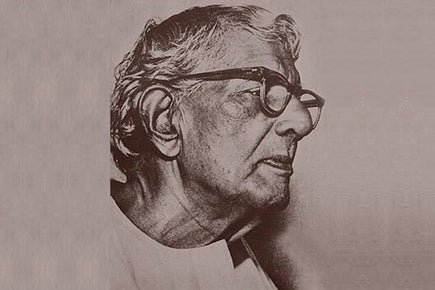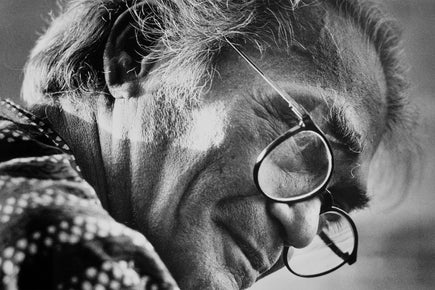Pierre Jeanneret: The Swiss Architect Who Fell in Love with Chandigarh
House number 57 in Sector 5 of Chandigarh, the capital city of Punjab, ushers visitors in with its beautiful, classic white-washed surfaces strewn with perforated brick screens and grey stone walls. Past its pleasing lawns, flowering plants and skirting trees, once inside, the two-storeyed ‘Maison Pierre Jeanneret’ takes you on a ride through the creations of Chandigarh’s first Chief Architect, Pierre Jeanneret.
 (Source: Image of Chandigarh Chairs - Martien Mulder at Phantom Hands; image of Pierre Jeanneret - gir.rs)
(Source: Image of Chandigarh Chairs - Martien Mulder at Phantom Hands; image of Pierre Jeanneret - gir.rs)
Housing Jeanneret’s modernist designs and numerous photographs, letters and trinkets, the museum offers a glimpse into the Swiss architect’s time in India and his creative process. Distinctive of Chandigarh’s renowned architectural finesse, the house-turned-museum’s haphazard windows come together in perfect consonance, ensuring that every nook is lit up in warm daylight. The building was restored to house the ‘Maison Pierre Jeanneret’ in 2017, after years of different families occupying it, and Jeanneret’s creations slipping into oblivion with each tenant that took over.

 The Maison Pierre Jeanneret (Source: ArchDaily/Paul Clemence)
The Maison Pierre Jeanneret (Source: ArchDaily/Paul Clemence)
A Symbiotic Partnership
Swiss-born Pierre Jeanneret, celebrated architect-designer Le Corbusier’s cousin, confidante and collaborator, lived in the house during his time in India. Born in Geneva on 22 March, 1896, Jeanneret graduated from the École des Beaux-Arts in Geneva and continued his studies in architecture in the École Nationale Supérieure des Beaux-Arts in Paris. It was in Paris that Le Corbusier – whose formal name was Charles-Édouard Jeanneret – took on the role of Pierre Jeanneret’s mentor, and the two entered into a partnership which lasted from the early 1920s until 1940. The brothers took up several projects together and developed their ideology of modernism during this period. They split up with the advent of the second world war due to political and ideological differences.
 Jeanneret and Corbusier sailing on Sukhna Lake (Source: bureauforopenculture.org)
Jeanneret and Corbusier sailing on Sukhna Lake (Source: bureauforopenculture.org)
In the 1950s, as Corbusier was appointed as the Chief Advisor for the Chandigarh project, he got Jeanneret to work with him. The cousins, who had already worked extensively together, complemented each other’s personality traits. Jeanneret’s high work ethic, architectural skills, knowledge of raw materials and modest and introverted nature allowed him to comfortably remain in the background, and strike a balance with Corbusier’s uncertain temperament.
Mirroring the Spirit of a New City
The city of Chandigarh was born out of the wounds of India’s 1947 partition, when Punjab’s capital Lahore was awarded to the western side of the state, which then became a part of Pakistan. The then-Prime Minister Jawahar Lal Nehru came up with the idea of Chandigarh as the new capital for Punjab. He entrusted Corbusier with the task of designing the city, who brought Jeanneret onboard. Today, decades after the city’s birth, it continues to be a paradise for architects from all over the world, and has earned recognition for its seamless and unique urban planning and design.
 Jeanneret looking at the plan of Chandigarh (Source: barnebys.fr)
Jeanneret looking at the plan of Chandigarh (Source: barnebys.fr)
Pierre Jeanneret, who was in Chandigarh from 1951 to 1965, lived in his self-designed house from December 1954 to August 1965. He designed furniture for his home using materials available locally, like bamboo, canvas and rope. This defined Jeanneret’s working style – he took utmost care in understanding the ethos of Chandigarh, and created furniture and buildings that echoed its simplistic charm. He was also deeply conscious in his use of locally available material and craftsmen for his projects.
 Furniture pieces designed by Jeanneret (Source: Wall Street Journal/Canadian Centre for Architecture)
Furniture pieces designed by Jeanneret (Source: Wall Street Journal/Canadian Centre for Architecture)
Pierre Jeanneret was instrumental in the infrastructural development of Chandigarh. He designed a significant share of the city’s government housing, educational institutions, shopping centres, and the State Library and Town Hall, amongst others. Apart from this, Jeanneret also supervised the implementation of Corbusier's designs, like the Capitol Complex, Museum and Art Gallery, and the City Centre. In 1955, he was appointed the Chief Architect of Chandigarh and Town Planning Advisor to the Government of Punjab.
 Capitol Complex, Chandigarh (Source: Hindustan Times)
Capitol Complex, Chandigarh (Source: Hindustan Times)
Jeanneret was tasked with carrying out Corbusier’s ambitious Capitol Complex project, which comprised several monuments including the Legislative Assembly, Secretariat, and High Court of Punjab. The complex was added to the prestigious list of UNESCO World Heritage Sites in 2016. The Gandhi Bhawan, an auditorium within the Punjab University campus, is considered to be one of Jeanneret's finest buildings in Chandigarh.
 Gandhi Bhawan, Punjab University, Chandigarh (Source: Flickr/Shubh M. Singh)
Gandhi Bhawan, Punjab University, Chandigarh (Source: Flickr/Shubh M. Singh)
Iconic Designs that Lay Forgotten
Pierre Jeanneret fell in love with India and studied the country’s people, landscape, climate and culture closely, and this made up the essence of his architectural and furniture designs – highly-detailed yet simple, reflecting the land that they were a part of and rooted in the ideas of comfort and simplicity.
 A bookcase designed by Pierre Jeanneret (Source: Sotheby's)
A bookcase designed by Pierre Jeanneret (Source: Sotheby's)
Jeanneret designed furniture both independently as well as with Corbusier. His furniture was much like his architectural designs – minimalistic, modern, utilitarian and true to the essence of Chandigarh. Many of his iconic designs like the famous Chandigarh Chair were left battered and forgotten in the city’s government offices and other such spaces for years on end, until collectors from around the world started taking notice of these forgotten gems. Today, these pieces are coveted collectibles and fetch lakhs of rupees at top international auction houses.
 Unrestored Chandigarh Chairs (Source: toomeyco.com/Simon Preston Gallery)
Unrestored Chandigarh Chairs (Source: toomeyco.com/Simon Preston Gallery)
An introverted and compassionate genius, Pierre Jeanneret was great friends with his cook and caretaker while he lived in his quaint brick-and-stone home in Sector 5. In his time there, Jeanneret also used to build boats and sail them in the Sukhna Lake, at the foothills of the Himalayas. Though the architect left India by 1965 as his health was failing, his legacy lived on through his iconic modernist designs. He passed away in 1967 in Geneva, where he was under the care of his niece, and as per his wishes, Jeanneret’s ashes were laid to rest in the waters of the Sukhna Lake, in his beloved Chandigarh.
 A reproduction of the iconic Chandigarh Chair; click to shop on Artisera
A reproduction of the iconic Chandigarh Chair; click to shop on Artisera
























































































